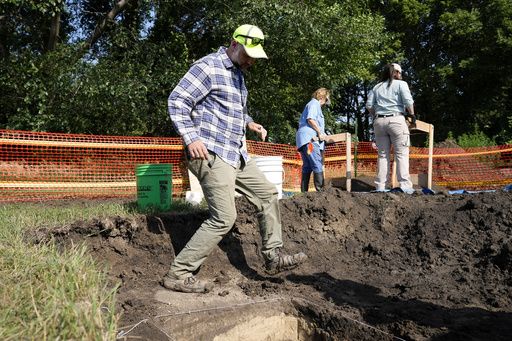No children’s remains found in Nebraska dig near former Native American boarding school
Nebraska State Archeologist Dave Williams walks in a hole as workers dig for the suspected remains of children who once attended the Genoa Indian Industrial School, Tuesday, July 11, 2023, in Genoa, Neb. The mystery of where the bodies of more than 80 children are buried could be solved this week as archeologists dig in a Nebraska field that a century ago was part of a sprawling Native American boarding school. (AP Photo/Charlie Neibergall)
An archeological dig for a lost children’s cemetery near the Nebraska site of a former Native American boarding school has ended after two weeks — and no remains were found.
Dave Williams, the state’s archeologist, said the team searching near the former Genoa Indian Industrial School plans to meet on Zoom with representatives of 40 tribes across the U.S. next week to determine next steps.
“I would have preferred that we found the children,” said Judi gaiashkibos, a member of the Ponca Tribe of Nebraska and the executive director of the Nebraska Commission on Indian Affairs. “But we have to remain hopeful. They’ve been gone more than 90 years. I feel like I have to remain steadfast and committed.”
The search for gained renewed interest after hundreds of children’s remains were discovered at other Native American boarding school sites across the U.S. and Canada in recent years.
Dogs trained to detect the odor of decaying remains searched the area last summer and indicated there could be a burial site in a strip of land bordered by a farm field, railroad tracks and a canal. In November, ground-penetrating radar identified four anomalies — or areas of disturbed soil beneath the ground surface — in the shapes of graves.
Williams and his team spent the last two weeks excavating, but didn’t find the first anomaly they were seeking, which could’ve contained children’s remains.
“That’s one of the challenges of archaeology,” Williams said. “We can have a lot of evidence that something should be where we think it’s going to be. And then once we actually get in and open up the ground and take a look, it’s not what we expected.”
They’ll spend the next few weeks reevaluating the data and everything that led them to that location, Williams said, and figure out a new plan in consultation with the dozens of tribes that lost their children to the school.
There are three other anomalies nearby. Crews could search for those, pursue other leads or stop the search entirely if the tribes collectively decide that’s what they want, Williams said, but he hopes the team can still help the tribes, find the children and “bring them to rest in a satisfactory way.”
Sunshine Thomas-Bear, a member of the Winnebago Tribe of Nebraska and the cultural preservation director for the tribe, said she wishes there had been more consultation with all 40 tribes — and not just the tribes in Nebraska — before now. She’s looking forward to that happening more in this next phase.
“Nothing was found this time. But perhaps that was because we weren’t all ready yet,” Thomas-Bear said. “There were tribes that weren’t notified, there were tribes that weren’t there. We believe that everything happens for a reason. I think that if we get on the right track together, perhaps we’ll be more successful.”
The Genoa Indian Industrial School was part of a national system of more than 400 Native American boarding schools that attempted to assimilate Indigenous people into white culture by separating children from their families, prohibiting them from speaking their Native languages, cutting them off from their heritage and inflicting abuse.
The school, about 90 miles (145 kilometers) west of Omaha, opened in 1884 and at its height was home to nearly 600 students. It closed in the 1930s and most buildings were demolished long ago.
The U.S. Interior Department — led by Secretary Deb Haaland, a member of Laguna Pueblo in New Mexico and the first Native American Cabinet secretary — released a first-of-its-kind report last year that named hundreds of schools the federal government supported to strip Native Americans of their cultures and identities.
At least 500 children died at some of the schools, but that number is expected to reach into the thousands or tens of thousands as efforts like the Nebraska dig continue.
___
Trisha Ahmed is a corps member for the Associated Press/Report for America Statehouse News Initiative. Report for America is a nonprofit national service program that places journalists in local newsrooms to report on under-covered issues. Follow Trisha Ahmed on Twitter: @TrishaAhmed15
Copyright 2023 The Associated Press. All rights reserved


